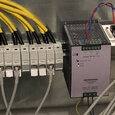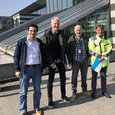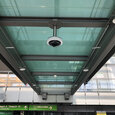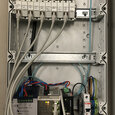
Smooth rollout of IP video system at Dortmund Airport
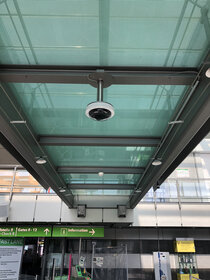
From the heart of the Ruhr region out into the world
25 countries can be reached directly from Dortmund Airport. According to the 2021/2022 winter flight schedule, there are 42 destinations to choose from at the third-largest airport in North Rhine-Westphalia. Katowice has topped the list of top destinations for several years, followed by London, Majorca, Bucharest and Sofia. Of course, the Ruhr airport was also affected by the decline in passenger numbers during the pandemic, but the future is nevertheless viewed positively in Dortmund. This makes it all the more important for Flughafen Dortmund GmbH to keep the infrastructure up to date at all levels. In a comprehensive project, the company has now renewed the ageing video surveillance system, including the underlying network infrastructure.
Moving towards digital technology
The first video surveillance system at Dortmund Airport was put into operation in 2000: Analogue technology based on video conference rails and fiber optic cabling. In 2014, the first digital video management system was introduced and whenever an analogue camera failed, it was directly replaced by an IP camera. After a pilot phase with several video cameras, Eberhard Reinsch, project manager of the video surveillance project, settled on one model. This paved the way for replacing the existing infrastructure with a holistic, digital concept. One thing was clear to Eberhard Reinsch and Ulf Fiand, responsible for network technology: the video cameras should no longer be connected directly via fiber optic cables. On the one hand, the existing old fiber optic cables could no longer be used, and on the other hand, they wanted to minimize the number of additional active components, as both saw an increased risk of failure.
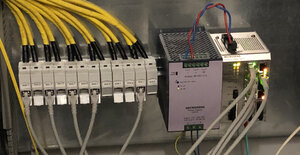
Power via the network (PoE) to the IP camera
The concept proposed by MICROSENS convinced the airport. The robust Gigabit Ethernet switches of the Profi Line Modular (PLM) series offer both fiber optic ports and copper connections with Gigabit Ethernet. The Power-over-Ethernet option of the MICROSENS switches allows the video cameras to be supplied with power via the network. This eliminates the need for a separate cable for the power supply. The extended temperature range of the switches is between -40 and +75 degrees Celsius. This means that smooth operation can also be guaranteed in halls that are not temperature-controlled. In addition to the facts, the previous experience of the IT team also spoke in favor of the MICROSENS components. Ulf Fiand explains: "We have been working with MICROSENS micro switches for many years in order to connect workstations simply and quickly via copper lines and still use fiber optics in the backbone. The products work very reliable and stable."
In addition, Talk GmbH from Dortmund, which was responsible for the entire cabling and implementation of the network technology on the airport premises, developed an integrated solution for the installation of the various components together with MICROSENS: The DIN-rail mounted switches, a fiber optic patch field as well as an additional fuse unit are mounted in a robust housing. For the most part, these housings are fitted with a transparent cover so that visual inspections can also be carried out. At the same time, the components are protected from dust and unauthorized access.
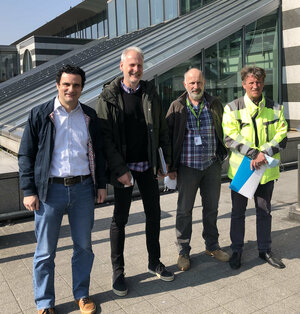
From planning to a running system
The project was accomplished in two phases. In phase 1, the new video management system was implemented. In phase 2, Talk GmbH installed the cabling and the switches. 30 PLM switches from MICROSENS - either as 13- or 7-port models - were installed throughout the entire airport area. These distributed switches were redundantly connected to the core switches via two 10 Gigabit 28-port Ethernet switches L2+ from MICROSENS. Step by step, the video cameras were then replaced. In order to guarantee security at all times, the analogue cameras first had to be integrated into the video management system, after which the new cameras were installed, connected to the switch via the cabling and activated. After successful functional testing of each new camera, the analogue camera was removed. During the cabling, the experience of the Talk team proved to be extremely beneficial, as Ulf Fiand explains: "The Talk experts managed to further optimise the cabling on site, especially in critical cases." Only at one location an additional PoE injector had to be installed near the camera, as the power supply via PoE and more than 100 metres distance was not sufficient for the motion control. An advantage for the airport's technical team is also the easy monitoring and configuration of the switches. This can be done either centrally via the MICROSENS network management platform or individually for each switch via the web interface.
Safely into the future
The video surveillance system currently consists of more than 200 cameras distributed throughout the airport premises. There are 17 different operating locations available, which - based on the respective access rights of the user - only allow access to certain camera recordings. For example, the monitoring of the security checkpoints as well as parts of the airspace are handled by employees of the district government. The video cameras for monitoring the apron, the runways, the car park entrances and checkouts as well as the baggage conveyor systems, serve the airport's own security. In addition, a police surveillance station is monitoring the airport as well. The experiences with the network for the video management system have been consistently positive, as Ulf Fiand confirms: "From our point of view, the project was very successful. The entire network works very stable and reliable. Both the implementation by talk and the MICROSENS switches are outstanding"
Copyright
Cover Picture: Flughafen Dortmund
O firmie MICROSENS
Przesyłanie informacji za pomocą połączeń światłowodowych oferuje liczne korzyści. Firma MICROSENS GmbH & Co. KG dostrzegła to bardzo wcześnie. Jako jeden z pionierów firma od 1993 roku projektuje i produkuje w Niemczech wysokowydajne systemy komunikacyjne i transmisyjne. Indywidualnie dopasowane do wymagań różnych obszarów zastosowań i osadzone w kompleksowych koncepcjach dla poszczególnych branż. Ale przede wszystkim blisko klienta. Wyzwania techniczne wynikające z projektów klientów są bezpośrednio uwzględniane w rozwoju produktów. W ten sposób powstają rozwiązania automatyzacji oparte na IP dla nowoczesnych budynków, ekonomiczne koncepcje sieciowe dla biur i miejsc pracy, solidne i odporne na awarie rozwiązania dla środowisk przemysłowych, przyszłościowe optyczne systemy transportowe dla sieci rozległych oraz efektywne łączenie zakładów i centrów komputerowych.








